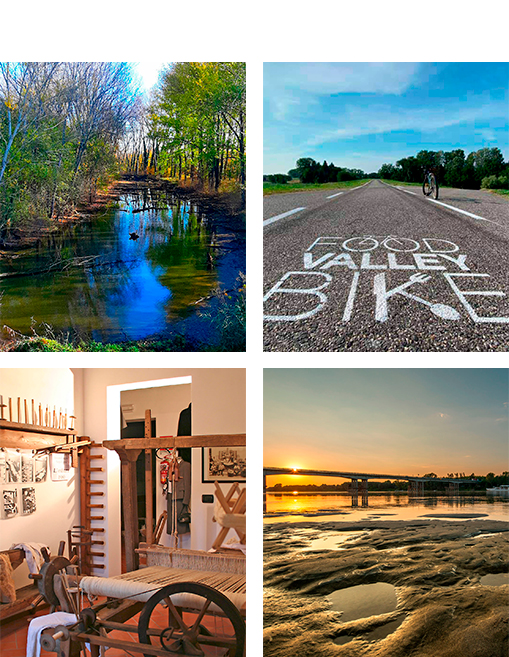Parma
Parma is one of the main cities along the ancient Via Emilia, which has been a busy centre for merchants and travellers since Roman times. Ever since, Parma’s history has further prospered and the city has become a hub of Emilian, Italian, and internationalo culture.
If you come to Parma, you cannot fail to discover the French influences, in particular that of Maria Luigia, Napoleon Bonaparte’s wife who lived here and gave the city a special flair.
When you think of Parma, you can only imagine some of its iconic monuments such as the Duomo and Baptistery, the Farnese theatre, the fountains in the Parco Ducale, the Paganini Auditorium, the Regio Theatre and the Citadella.
If you are in Parma, you cannot miss out on discovering its food culture by entering delicatessens, wine shops and restaurants to find the products appreciated, envied and bought by the whole world: from Parmigiano Reggiano and Parma ham, Culatello from Zibello, Felino salami, anolini, torta fritta… and many other traditional products and dishes.
But you cannot forget to pay homage to Giuseppe Verdi, Niccolò Paganini and Arturo Toscanini, who changed music in Parma and took it all over the world.
There are many reasons to come to Parma during L’Etape by Tour de France.

...Discover the city and its surroundings on Parma Welcome...
Montechiarugolo
From the Latin Mons Clariculus, meaning “clear, treeless mountain”, it changed over time to Monteclaruguli.
The village of Montechiarugolo, with its medieval layout, lies at the foot of the well-preserved castle of the same name.
The village and the castle are closely linked to each other and to the history of the Torelli family, who ruled here for more than two hundred years, from 1406 to 1612. From 1545, Pomponio Torelli – a great humanist and man of letters, diplomat and ambassador of the Farnese family in Italy and Europe – trasformed the castle into a real court.
On 4 October 1796, the village and castle were the scene of the “Battle of Montechiarugolo”, that is considered the first clash of the Italian Risorgimento, in which the Tricolour flag was supposedly used for the first time by the Reggiana Civic Guard.
Montechiarugolo, with ten working dairy companies, is the area of origin of Parmigiano Reggiano. In the hamlet of Monticelli Terme you can relax while you enyoy the beneficial properties of the salso-bromo-iodine and sulphurous waters of the Borrini Spa, in activity since 1925.
WHAT TO SEE
Montechiarugolo Castle was built on the remains of an old 13th-century fortress.
Church of San Quintino was rebuilt on the original Romanesque church and its external apsidal part is still preserved.
Palazzo Civico, dating back to the late 16th century, is a building erected on the remains of an earlier 15th century palace.

Collecchio
The area of Collecchio extends south-west of Parma in a splendid landscape nested between the hills and the plains, where people live in a special relationship with the surrounding natural environment not least because of two historic regional parks – the Taro River Park and the Carrega woodland.
Artistic and natural treasures are the precious backdrop to Collecchio nowadays, an urban centre bustling with both economic development and cultural-community life.
It is worth visiting the historical-artistic heritage preserved from medieval times, when Culliculum thrived under the bishops of Parma and was a significant stop-over along the Romea Road.
Collecchio is a successful example of sustainable development: the great food farming tradition of this area, with a network of small and medium-sized companies and industries of international standing has been integrated with an effective environmental policy that is a prerequisite for quality production.
This include the cured meat processing industry, first and foremost Parma ham, the dairy business with Parmigiano-Reggiano and Parmalat – the leading long-life milk company – and the tomato canning industry, which at the beginning of the second decade of the 20th century already counted around seventy companies in the Parma region.
Still, the real added value is the people of Collecchio: a community that stands out for its inclination for social solidarity that expresses itself in dozens of voluntary associations engaged in social, health, cultural, and sports activities.
Welcome everyone

Sorbolo Mezzani
The municipality of Sorbolo Mezzani arose in 2019 from the merger of the municipalities of Sorbolo and Mezzani.
The pride of the area is the "Parma Morta" Nature Reserve, which protects the former Parma riverbed where, until the 19th century, the waters of the torrent flowed before entering the Enza torrent. It is an authentic haven for animal and plant species that have now disappeared from much of the Po Valley.
Also in Mezzani, surrounded by the greenery along the Po river, lays the tourist river marina, an ideal mooring for those who want to immerse themselves in nature on the banks of the great river in a welcoming and large recreational green area.
The towns of the municipality preserve a number of interesting buildings, including the Church of San Michele and the Bishop’s Palace in Mezzano Superiore, the Church of the Annunciation in Mezzano Rondani, the Church of the Nativity of the Virgin Mary and the Oratory delle Grazie in Mezzano Inferiore, the Church of San Silvestro in Casale, the Torrione in Coenzo, and Casa Pezzani in Sorbolo.
In the area the Casa delle Contadinerie di Coenzo is particulalry interesting, as it houses a museum displaying a variety of ethnographic material that bear witness to the life of the local people in the late 19th and early 20th century.
The area also features the initial sector of the Food Valley Bike, the 80 km cyckle track connecting Parma and Busseto.


























































